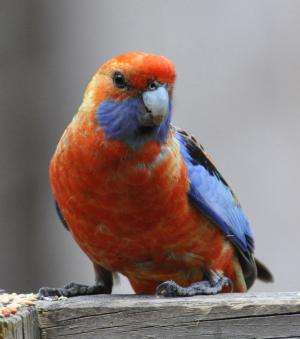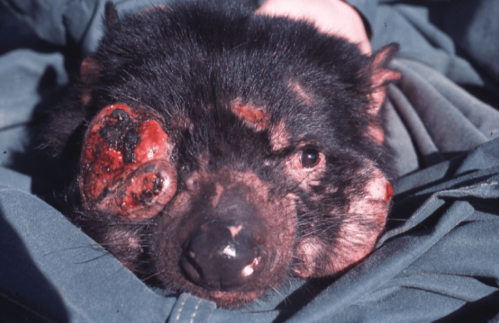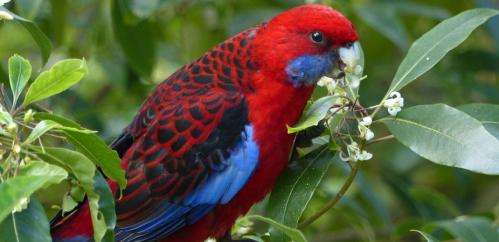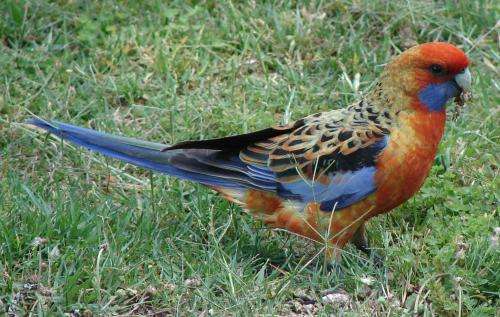The Adelaide Rosella (Platycercus elegans adelaidae) subspecies which has blotchy orange colouration. Credit: Raoul Ribot, Author provided
Despite its name, the Crimson Rosella is perhaps Australia's most colour-variable bird and a cause of this striking and beautiful diversity seems to be a disease that's potentially deadly to many other parrots.
Hybrid forms of the Crimson Rosella have lower loads and lower prevalence of this virus than the parental subspecies, according to our research published this month in the Proceedings of the National Academy of Sciences.
The Crimson Rosella will be familiar to many people as it's often found in gardens, towns, and cities along the east coast and south east of the continent.
It's colour ranges from deep crimson red, to pale yellow. Around Adelaide the subspecies is known as the Adelaide Rosella, and along the Murray and Murrumbidgee the pale yellow subspecies is known as the Yellow Rosella.
All forms (Adelaide, Yellow, Crimson and hybrids) are together classified as one species, Platycercus elegans the common name of which is the Crimson Rosella.
What maintains the extraordinary amount of plumage colour variability within this single species has long fascinated evolutionary biologists.
A virus cause for variety
Our new work suggests that something known as Beak and Feather Disease Virus (BFDV) is probably helping to maintain the variability.
Many Australians know that diseases can be bad for wildlife, such as the Tassie devil facial tumour disease where there's a risk it may cause extinction of the species.
But with the Crimson Rosella the disease seems not to be all bad, in the sense that it seems to be contributing to the biodiversity within the species.
Co-evolutionary arms races exist between hosts and their diseases. Hosts evolve to escape from disease while diseases evolve to improve their success in hosts.
In this sense, hosts are constantly "running" to escape their disease, in a process dubbed The Red Queen hypothesis after Lewis Carroll's Through the Looking-Glass, where the Red Queen advised Alice she had to run to stay in one place.
A Tasmanian Devil with a facial tumour. Credit: Wikimedia/Menna Jones, CC BY
The Red Queen has been a most influential hypothesis. Eminent evolutionary biologists and ecologists Bob May, now at Oxford, and Bill Hamilton devoted much of their lives to understanding these complex processes, many of which often can only be understood mathematically.
The virus threat to parrots
BFDV is only found in parrots and how nasty it is varies from species to species. In some species it can be really nasty – leading to extensive feather loss and death.
The Australian Government lists BFDV as a Key Threatening Process to biodiversity under the Environment Protection and Biodiversity Conservation Act 1999 (EPBC Act).
BFDV is a serious cause of concern in Australia. In endeavouring to prevent the Orange-bellied Parrot and other vulnerable parrots such as the Glossy Black Cockatoo from going extinct, wildlife monitoring programs and captive breeding programs are bedevilled by BFDV, or the risks of BFDV entering their systems.
BFDV is also of global conservation concern. BFDV may be confined to parrots, but as around 25% of the world's approximately 350 species of parrots are estimated to be at risk of global extinction - the highest number of species at risk in any bird family - any additional threat from BFDV needs to be rapidly understood and minimised.
Why study Crimson Rosellas?
From our research, it currently appears that BFDV in Crimson Rosellas is rather benign. This is not only good news for Crimson Rosellas, it also makes it an excellent model species in which to study the disease.
Perhaps then a good analogy for BFDV is "like the flu" – more often not too bad, but it can kill.
Over the last eight years we collected samples from birds across South Australia, Victoria and southern New South Wales. Striking differences in the disease prevalence and load began to emerge.
A Crimson Rosella (Platycercus elegans) in the wild near Melbourne. Credit: Raoul Ribot, Author provided
Birds from the hybrid and phenotypically intermediate forms (the Adelaide Rosella, and hybrid forms occurring between Gundagai and Albury) having much lower levels of the disease.
We found that host population density, parrot community diversity and composition did not explain the differences in BFDV prevalence or BFDV load. Subspecies was the most important predictor of load and prevalence.
One explanation is that hybrid and intermediate forms are more resistant to the virus. Such effects would maintain gene flow between parental and hybrid subspecies, and through hybrid fitness advantages help maintain the colour diversity within the species.
We also sequenced the BFDV virus. This confirmed that our BFDV is different to that in other parrot species. It also revealed that Crimson Rosella BFDV changed across subspecies in a unique pattern. Rarely has population structure of a disease in a free-living host been studied, so our study is rather unusual.
Although BFDV appears to be rather benign in the Crimson Rosella it may still be infecting other parrot species, and with serious affects. As Crimson Rosellas are common and geographically widespread, this risk needs to be determined.
A Western Slopes hybrid also with blotchy orange coloration. Credit: Mathew Berg, Author provided
That is part of new research and our hope is that by better understanding how BFDV affects birds we may be able to reduce the extinction risk to parrots. We also aim to understand how disease and wildlife interact and coevolve, including the circumstances under which disease can promote speciation.
Whatever the effect of BFDV on maintenance of colouration, our work suggests that hybridisation can potentially provide an escape from disease, and this could be applied to some threatened species.
In addition, as 70% of emerging infectious diseases of humans come from wildlife (think Hendra, Ebola and Avian Influenza), it can only be beneficial that Australia has a better understanding of its wildlife diseases, and their ecology and evolution.
Provided by The Conversation
This story is published courtesy of The Conversation (under Creative Commons-Attribution/No derivatives).![]()


























